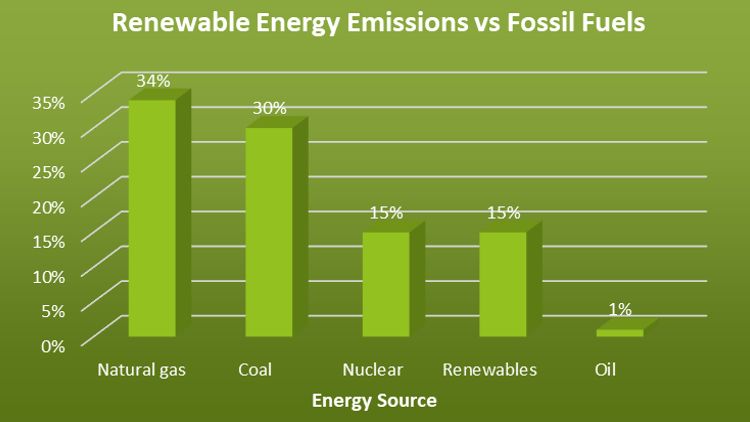Negative Effects Of Non Renewable Energy
Depletion of Resources

Non-renewable energy sources like oil, natural gas, and coal are finite resources that will eventually be completely depleted. According to the OECD Environmental Outlook report, global fossil fuel reserves are projected to run out within the next 50-100 years at current consumption rates.
Oil is expected to be the first fossil fuel to be fully depleted. Current global oil reserves are estimated at 1.65 trillion barrels, which is projected to run out around 2052 at today’s extraction rates (OECD). Natural gas reserves are projected to last longer, estimated until 2068, while coal could last until 2112.
As non-renewable resources become more scarce, extraction costs will increase dramatically. This may lead to price shocks and volatility, potential economic crises, and the depletion of critical resources that power the modern industrial economy. The depletion of cheaper energy sources will also drive more extraction of unconventional and high-cost fossil fuel sources, such as tar sands, with greater environmental impacts.
Pollution
Burning fossil fuels like coal, oil, and natural gas releases emissions that pollute land, air and water resources. According to the Natural Resources Defense Council, fossil fuels emit particulate matter, nitrogen oxides, sulfur dioxide, mercury and other heavy metals that contaminate our environment (https://www.nrdc.org/stories/fossil-fuels-dirty-facts).
Air pollution from fossil fuels causes 4.5 million deaths worldwide each year, according to a 2017 study published in Environmental Health Perspectives (https://www.activesustainability.com/renewable-energy/environmental-impact-of-non-renewable-energies/). These pollutants damage lungs, increase the risk of asthma and other respiratory illnesses. They also contribute to acid rain that harms forests, crops, wildlife and infrastructure.
Mercury emissions contaminate seafood and are especially harmful to children’s developing brains. Soot emissions accelerate snow and ice melt by darkening surfaces and disrupting weather patterns. Wastewater from mining and drilling pollutes local rivers, lakes and oceans.
Reducing reliance on fossil fuels and transitioning to renewable energy sources like solar, wind and hydropower would significantly curb pollution levels and improve public health.
Climate Change
The burning of fossil fuels like coal, oil, and gas releases greenhouse gases like carbon dioxide and methane into the atmosphere. These greenhouse gases trap heat and cause the planet to warm up over time. According to the IPCC report, human activities have caused approximately 1.0°C of global warming since pre-industrial times, with the overwhelming majority coming from fossil fuel emissions (Research on the Record).
If current emission rates continue, global temperatures are projected to increase by 2.5 to 4°C by 2100. This will cause major changes to weather patterns, rising sea levels, loss of biodiversity, and more extreme weather events. Some effects we are already witnessing include increases in drought, flooding, wildfires, and heat waves that impact human health, food security, ecosystems, and infrastructure. Sea levels have already risen over 20 cm in the last century, and are projected to rise between 28-98 cm by 2100, threatening coastal cities and small island nations (Climate Change and Development).
Climate change poses an existential threat to humanity if left unchecked. Curbing fossil fuel emissions is critical to limiting future warming and avoiding catastrophic climate impacts across the globe. The use of renewable energy sources can significantly reduce greenhouse gas emissions while meeting the world’s energy needs in a sustainable way.
Environmental Damage
The use of non-renewable fossil fuels such as coal, oil, and natural gas has frequently resulted in environmental disasters that have lasting damage to ecosystems and wildlife. Coal plants produce large amounts of coal combustion waste, with over 129 million tons generated in 2019 in the U.S alone. Coal ash spills, like the one from a TVA plant in Kingston, Tennessee that spilled 1.1 billion gallons, spread heavy metals and other toxins into waterways and soils, contaminating the environment and harming aquatic life (https://www.sciencedirect.com/science/article/abs/pii/S1342937X2100321X). Coal ash contains substances like arsenic, lead, mercury, cadmium, and chromium. The environmental damage can persist for years after a spill.
Similarly, oil spills from offshore drilling rigs or oil tankers have contaminated large areas of ocean and coastlines. The 2010 BP Deepwater Horizon oil spill in the Gulf of Mexico saw nearly 5 million barrels of oil released, covering over 1,300 miles of coastline and damaging marshes and beaches. The Exxon Valdez spill in 1989 devastated the coastal ecosystem in Alaska. Oil spills threaten marine life including fish, birds, sea turtles, and mammals, both from the toxicity of the oil and the difficulties cleaning up. The environmental impacts can last for decades after the disaster. Cleanup attempts through methods like oil booms, skimming, and chemical dispersants are often only partially effective. Restoring the natural state of affected ecosystems is an enormously difficult and costly endeavor (https://pers.uz.zgora.pl/skep-szukaj?wp_szukanie=1&wp_szukaj_fr=Energy&wp_gdzie_szukac=1&wp_rok_poczatek=1960&wp_rok_koniec=2021&wp_ile_na_stronie=25&page=11).
National Security Concerns
Dependence on foreign non-renewable energy sources like oil and natural gas can threaten national security and lead to global conflicts over resource access and pricing. For example, the U.S. invasion of Iraq in 2003 was partly aimed at securing oil reserves in the region. Supply disruptions caused by political instability in oil-producing countries can also impact national security. According to the Council on Foreign Relations, U.S. reliance on imported oil “entails significant costs and risks, including higher prices, weaker economic growth, and risks of supply disruptions” (https://www.cfr.org/report/national-security-consequences-us-oil-dependency).
Geopolitical tensions frequently arise around resource-rich areas as nations compete for access and control. The Middle East in particular has been plagued by conflict due to its abundant oil reserves. U.S. foreign policy has been shaped in part by the need to maintain strategic relationships with major oil producers like Saudi Arabia. Reducing reliance on imported oil through renewable energy sources can therefore promote national security.
Energy independence powered by renewables provides strategic and economic benefits for national security. The U.S. Department of Energy states that “having enough energy to meet demand and having a power system and infrastructure that are protected against physical and cyber threats” are key to energy security (https://www.energy.gov/eere/energy-independence-and-security). Investing in domestic renewable energy allows nations to become more self-sufficient and less beholden to external energy suppliers.
Public Health
The hazardous pollutants emitted from non-renewable energy generation can have serious effects on public health. Fine particulate matter, nitrous oxides, sulfur dioxide and mercury emitted from burning coal and other fossil fuels have been linked to increased risk of illness and death from lung and heart conditions. According to a Harvard study, exposure to fine particulate matter from fossil fuel combustion results in over 52,000 premature deaths per year in the United States alone. Children, the elderly and those living in proximity to power plants are especially vulnerable.
A 2011 study published in the New England Journal of Medicine estimated that the life expectancy of every person in the US is shortened by an average of 1 year due to emissions from burning fossil fuels. The World Health Organization estimates 4.2 million people a year die prematurely from conditions attributed to ambient air pollution, much of which comes from non-renewable energy generation.
The healthcare costs associated with the health impacts of fossil fuel emissions are substantial. A 2020 study in Environmental Research found the annual healthcare costs in the US attributable to fossil fuel combustion totals $820 billion. Investing in renewable energy and transitioning from fossil fuels would significantly reduce illness, improve public health and generate major healthcare savings.
Job Market Changes
As non-renewable energy sources like oil, gas and coal deplete over time, jobs in the fossil fuel industries are declining. According to a 2022 report, fossil fuel companies cut over 7,100 jobs in 2021 despite industry growth. This represents a nearly 12% decline in fossil fuel employment over the previous year. Source
At the same time, jobs in renewable energy sectors like solar, wind and geothermal are rapidly increasing as adoption of these technologies grows. Green energy jobs rose by over 5% in 2021, adding over 17,000 new jobs in wind, solar and other clean technologies. Source
As the global economy transitions away from fossil fuels, significant training and educational programs will be needed to help fossil fuel workers transition into growing industries like renewable energy. Investing in workforce training and development will be crucial to ensure a just transition for energy sector workers.
Other Environmental Impacts
Non-renewable energy such as coal, oil, and natural gas have significant negative impacts on the environment beyond pollution and climate change. Extracting and transporting fossil fuels requires clearing land which leads to habitat loss, species extinction, and reduction in biodiversity. Fossil fuel operations also use massive amounts of water which gets contaminated in the process. For example, fracking utilizes between 1.5 and 16 million gallons of water per well and much of this water returns to the surface contaminated with chemicals and high salinity levels.
Mining and drilling for fossil fuels disturbs soil and causes erosion. Strip mining removes nutrient-rich topsoil which takes centuries to regenerate naturally. The loss of topsoil leads to desertification in many regions. Transporting coal as slurry through pipelines requires large amounts of water that gets contaminated and ruins farmland. There are many environmental damages caused by non-renewable energy that go beyond air and water pollution.
Economic Costs
Fossil fuels and other non-renewable energy sources often require significant government subsidies and have major externalized costs that are passed on to society. According to research, global fossil fuel subsidies reached $5.2 trillion in 2017, creating market distortions and inefficiencies. These subsidies prop up non-renewables and distort comparative costs relative to renewables.
There are also substantial external costs associated with non-renewable energy like air and water pollution, environmental damage, and health effects that are borne by society. One study estimated these external costs to be over $4 trillion annually for fossil fuels. As renewable energy prices fall rapidly, the true costs of non-renewables become more apparent.
Multiple analyses show transitioning to renewable energy could produce considerable cost savings over time compared to continued reliance on non-renewable energy. Significant reductions in energy subsidies and externalized costs are possible with renewable energy adoption. This transition could also drive economic growth, create jobs, and provide energy access to more people globally.
The Sustainable Alternative
There is hope for transitioning to an energy system dominated by renewable sources that are clean, sustainable, and replenish naturally. Renewable energy comes from sources such as the sun, wind, water, plants, and geothermal heat. Key renewable energy sources and their advantages include:
- Solar power from photovoltaic panels – Provides emissions-free electricity without fuel costs, decentralized distribution, and rapidly declining costs.
- Wind power from large-scale wind farms – A mature technology supplying emission-free electricity at competitive prices.
- Hydropower from dams – A mature technology providing low-cost renewable electricity, energy storage, and flood control.
- Bioenergy from plant matter – Provides flexible renewable energy from agricultural and forestry feedstocks.
- Geothermal power from underground heat – Supplies constant baseline power from an abundant resource.
Projections show renewable energy rising from 12% of U.S. electricity generation in 2017 to 44% by 2050 if current policies are maintained, according to the U.S. Energy Information Administration. More ambitious scenarios envision renewables supplying 80-85% or more of global electricity by 2050 through rapid deployment and grid integration improvements, according to reports by IRENA and the International Energy Agency.
To realize this sustainable vision, policies must support renewable energy deployment while ensuring grid reliability. Public engagement and education are also needed to understand the urgency of reducing fossil fuel dependence. The transition will require effort and commitment, but will lead to cleaner air, a stable climate, green jobs, and long-term energy security.






